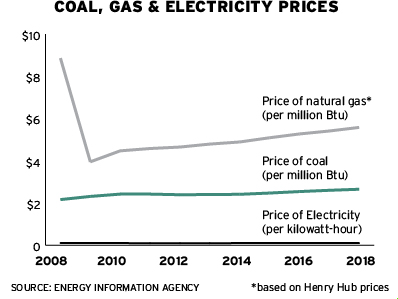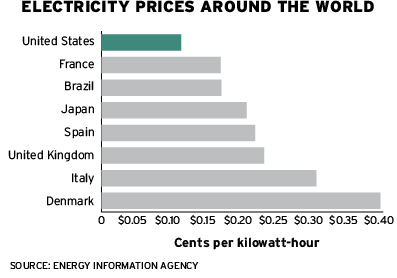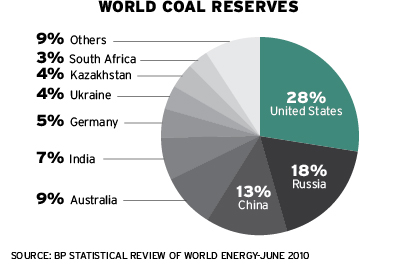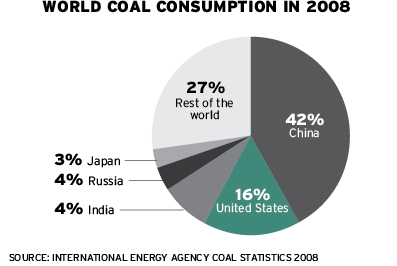The United States has a love/hate relationship with coal. Coal produces almost half of the country’s electricity, but it also has significant side effects on the environment, human health and the safety of coal miners. Although the energy debate has concentrated on renewable energy, coal is likely to remain the largest single source for electricity generation in our near future. But why do we remain so dependent on this relationship?
1. It fits our budget
The prospect of cheap electricity is the sparkle that draws our eye to coal. Coal is a major player in assuring Americans enjoy some of the lowest costs of electricity among the world’s industrialized nations.
The price of producing coal-fired electricity is less than any alternative source of energy, including other fossil fuels like natural gas, and renewable sources like wind. Natural gas is the closest subsitute for coal. Although some natural gas plants are more efficient than coal plants at generating electricity, the cost of generating one kilowatt-hour of electricity from natural gas is generally higher than that of coal. Of the 25 most cost-effective plants in the U.S., 22 operate with coal.
Coal deposits are readily accessible for extracting through traditional underground mines, strip mining or mountaintop removal sites. The industry’s recent shift from the Appalachian region to the West, where coal is easier to extract and more abundant, has helped keep energy costs low. With coal being so available, its commercial success depends on the industry’s capacity to improve mining logistics and develop reliable routes to transport it to markets.
The following table illustrates the consistency of coal prices over time, in contrast to the highly volatile behavior of gas prices.


2. There’s lots of it

The U.S. harbors close to one-third of the global total coal reserves. The abundance of coal reinforces our dependence on this relationship.
At current consumption rates, coal reserves in the U.S. could last for another 249 years, according to the Energy Information Administration. But if consumption increases as expected, U.S. coal reserves could be depleted in as few as 120 years.
According to the U.S. Department of Energy, coal reserves are estimated to be larger than the world’s known oil deposits. Oil and gas form under special geological circumstances and are concentrated in only a few countries. In contrast, coal is more widely available around the world.
3. It’s there when we need it
Most marriage counselors might agree that security and reliability should provide a foundation for any relationship. Coal provides both to Americans. Energy security is facilitated by two factors: a reliable supply of resources and price stability. The U.S. has a reliable supply of coal whose price is virtually immune to the behavior of international markets—in contrast to the prices of oil that are affected by the behaviors of market cartels such as the Organization of Petroleum Exporting Countries (OPEC).
Approximately 95 percent of the coal consumed in the United States is mined within its borders. Because coal is mined locally, supply issues, such as mining or transportation problems, can be addressed more easily and promptly than in international or long-distance relationships.
Coal prices show little volatility over time—compared to substitutes such as natural gas—because of long-term coal supply contracts with mining companies. According to the EIA, the average coal price in the United States is expected to increase only 2 percent per year from 2009 to 2035, while the price of natural gas is expected to increase 4 percent annually.
4. It’s bigger than U.S.

Lately, coal has been pursued by a group of rich admirers, such as China, India and other emerging economies. The opening of export markets has put U.S. coal producers in a long-term position to cash in on the global appetite for electric power.
Worldwide, coal has been the fastest-growing fuel used for electricity since 2000, particularly because of an increased demand for power from China and India. In India, for example, 70 percent of electricity is generated from coal. Similarly, it is estimated that 83 percent of China’s electricity is coal-fired. To support this growth, China’s demand for coal increased 185 percent in the last decade. China is now the globe’s biggest buyer of coal and is responsible for almost half of global consumption.
5. We’ve got issues
The complexity of our relationship with coal makes its regulation challenging politically and economically. Coal has been the main source of electricity in the U.S. since World War II. Among the issues growing over that time are jobs vs. mining risks, industry vs. environmental and health effects, and U.S. policy vs. global needs.
With the U.S. undergoing an economic recession, any discussion on regulations that could affect jobs can easily become political, particularly in states that have high employment from the coal industry. According to figures from the U.S. Bureau of Labor Statistics, the coal mining industry employed 81,000 Americans in 2010. Many more are employed in power plants and other industries associated with coal, such as transportation and services. Estimates from a report from PricewaterhouseCoopers for the Coal Mining Association put the number as high as 550,000 jobs.
For those working in mines, the industry can be lucrative. According to the Bureau of Labor Statistics, in 2008, mineworkers earned $23.27 per hour, compared to the private industry average of $18.08 per hour. In regions such as Appalachia, mines are the main employers. More than half of mine employees are located in three states: Kentucky, Pennsylvania and West Virginia, according to the Energy Information Administration. Other states employing large numbers of coal miners are Alabama, Illinois, Indiana, Virginia and Wyoming. Moving away from coal dependency in these regions would require substantial efforts by state and federal governments to diversify local economies. Meanwhile, politicians from these states often advocate for the protection of the coal industry.
Reducing local pollution and making mining safer for workers are politically sensitive issues. Some groups argue that any regulation would hurt U.S. businesses by increasing their production costs. Critics say that without any government regulation, the human price tag associated with coal, such as long-term health effects, will fall on U.S. taxpayers. The politicization of this debate has made it difficult to reach consensus on energy policy.
From an international perspective, implementing any policy to address the effects of global warming would require consensus from the world’s largest nations, many of which have diverging interests. Global warming affects everyone, regardless of where pollution originates. Regulating greenhouse gases could prompt businesses to move to industrializing countries where they can still pollute freely. Losing businesses to those countries could hurt U.S. jobs and economic opportunity and create political backlash.
